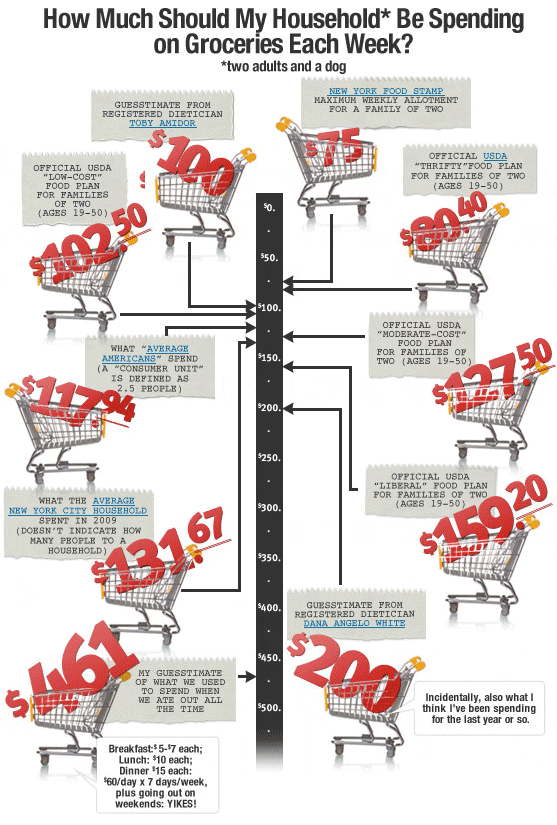The Second Obstacle to Sensible Eating: Money
Michael Pollan makes the point that we Americans spend less than 10 percent of our income on food, less than any other nation, but 16 percent on health care — more than any other nation. In this sense, at least, I am a typical American: Each year I put $5,000 into my flexible spending account without even flinching, not to mention what I pay in premiums and out-of-pocket costs. But this expense seems unavoidable to me, whereas spending on food seems, at least in part, discretionary.
Pollan argues that we should all spend more and eat less, meaning buy a smaller quantity of higher-quality foods — an idea I understand intellectually but have a hard time translating into purchasing decisions. I am oddly cheap about some items ($8 for jicama? Forget it!) yet extravagant about others (a pint of Ben & Jerry's Phish Food ice cream for $4.19? OK by me). Though planted squarely in the middle class (for now, anyway), I am clearly not putting my food dollars to their best use.

As I see it, there are three ways to focus your food-spending dollars: on getting the largest quantity of food for your money (as bargain shoppers do), on getting the most calories for your money (as poor people often must do), or on getting the best nutrition for your money (which seems to be the new wisdom). But my technique is not nearly so thought-out. My usual grocery list can be broken down into two kinds of food: the foods I want to eat (chocolate, coffee, peanut butter and jelly, orange juice, cereal, cookies, cakes, popcorn, snacks, ice cream), and the foods I think I should eat (fruits, vegetables, whole grains, etc.). Most of the foods I want to eat disappear within days, while some of the foods I should eat stick around for weeks, rotting, until I finally throw them out.
Since I've never really had a good sense of what a reasonable food budget for my household would be, a few years ago I arbitrarily chose a number — $100 a week — thinking it was reasonable for my husband and me to spend $5,000 a year on groceries. (Is it a coincidence that it's the same amount I put in my flexible spending account?) I still use that $100 figure, but truthfully, it's not enough (I live in New York City, where costs are high). I routinely drop another $40 to $60 at the farmers' market each week and/or another $20 to $40 on produce or other staples at local stores. And I still make poor choices — too many baked goods, chocolate, coffee-to-go, impulse buys — and I still labor over what to buy. Organic is better for the earth but can be significantly more costly than conventional. Buying local ensures freshness, but it's not always possible to find. I like chocolate, but I should eat lettuce.

So how do I fix this?
I've looked into how much others spend each week on food and found a huge range (see graphic below), but I still need to work on what to buy. And that's where you come in.
How do I figure out what to buy? Is it possible to purchase only what I need for a week, or will there always be some waste — is that just the price of having fresh food around? What is the best way to go about it? To shop daily, like Parisians? To meticulously plan ahead and shun spontaneity? To avoid dessert and convenience? To buy items with long shelf lives? To freeze all that is freezable? To spend more and eat less, as Pollan suggests?
Click on each shopping cart to see the source of information:

The challenge for this week is to see how little I can spend on food and still fulfill my dietary requirements (I'm not allowed to subsist simply on rice or oats for a week). How low can I go? This likely means no organic foods, no convenience foods, no Starbucks, no sugar or coffee unless it's already in the house. It means buying groceries and eating foods from home only.

















I'll blog about how the week is going, so be sure to check in periodically to see how looking at eating through the lens of cost changes my perceptions, awareness, and especially expenditures and to offer me advice on the dilemmas I face.
Also, let me know your thoughts on money and food. If you are comfortable sharing, tell me where you live (generally), how many people you buy food for, and what you spend each week. How much would you like to spend? Can you afford everything you want? Are there foods you want but don't buy? Are there foods you buy but wish you didn't?
I'm looking forward to reading your comments.
See a Magnum Photos gallery on food shopping around the world .
